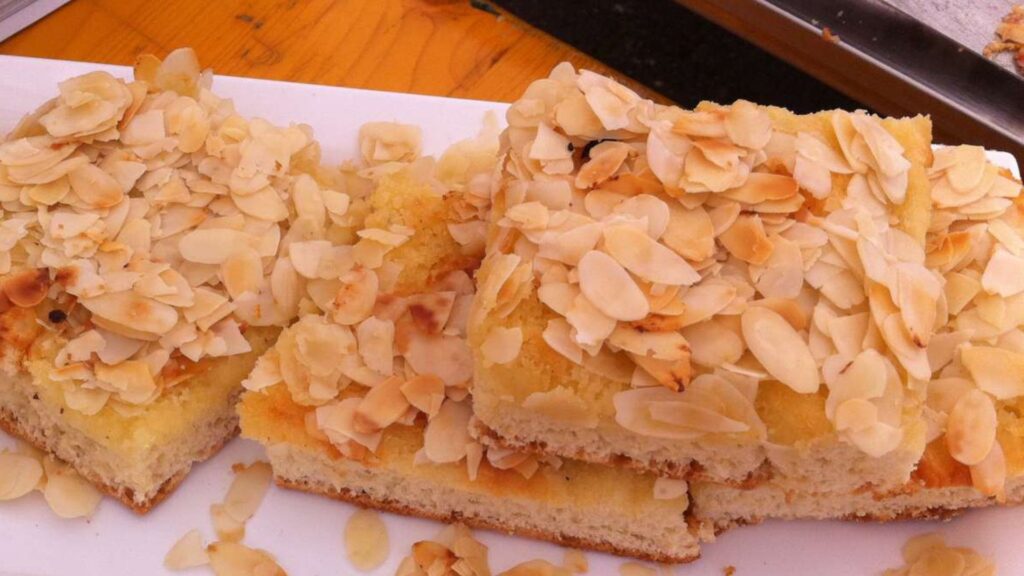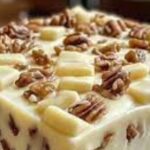This Recipe For Traditional German Butter kuchen Growing up around ovens and heirloom cookbooks, I learned that food carries more than flavor it holds memories.
Some recipes take me back to my roots, to the heart of tradition. After years of baking and tasting, I still return to one comfort food again and again.
After about ten minutes in the oven, the kitchen smells like nostalgia. That’s why I want to share my favorite recipe for traditional German Butterkuchen.
I love how simple it is. No fancy steps. Just honest ingredients and rich, buttery flavor. This cake brings warmth to any table—whether for celebration or remembrance.
Why Everyone Will Love It?
Everyone will love this Recipe For Traditional German Butter kuchen because it brings comfort in every bite. Its soft, pillow y texture and rich buttery flavor make it incredibly satisfying without being overly sweet.
The light crunch from the toasted almonds on top adds just the right contrast. It’s the kind of cake that feels familiar, warm, and homemade—the kind people remember and ask for again.
Whether served at a family gathering, afternoon coffee, or a quiet moment of reflection, it fits perfectly.
This cake isn’t just a dessert—it’s a simple, heartwarming experience that brings people together and leaves lasting impressions.
How To Prepare Recipe For Traditional German Butter kuchen
Recipe Details
Prep Time: 20 minutes
Cook Time: 25 minutes
Total Time: 45 minutes
Difficulty: Easy
Cuisine: German
Yield: 12 servings
Equipment Needed
- 9×13-inch baking pan
- Mixing bowls
- Electric mixer (optional)
- Measuring cups and spoons
- Spatula
- Small saucepan
Ingredients
For the Dough:
- 2¼ cups all-purpose flour
- ¼ cup granulated sugar
- 1 packet (2¼ teaspoons) active dry yeast
- ½ teaspoon salt
- ½ cup warm milk
- ¼ cup unsalted butter, melted
- 1 large egg
For the Topping:
- ½ cup unsalted butter, softened
- ½ cup granulated sugar
- 2 tablespoons milk
- 1 teaspoon vanilla extract
- ½ cup sliced almonds

How To Make
1. Preparing the Dough
1. Activate the Yeast: In a small bowl, combine warm milk and a pinch of sugar. Sprinkle the yeast over the milk and let it sit for about 10 minutes until frothy.
2. Mix Dry Ingredients: In a large bowl, whisk together flour, sugar, and salt.
3. Combine Wet Ingredients: Add the melted butter and egg to the dry mixture. Pour in the activated yeast mixture. Stir until a soft dough forms.
4. Knead the Dough: On a lightly floured surface, knead the dough for about 15 minutes until smooth and elastic.
5. First Rise: Place the dough in a lightly oiled bowl, cover with a damp cloth, and let it rise in a warm spot for about 45 minutes, or until doubled in size.
2. Assembling the Cake
1. Prepare the Pan: Grease a 9×13-inch baking pan.
2. Shape the Dough: Once risen, punch down the dough and transfer it to the prepared pan. Using your fingers, gently press and stretch the dough to cover the bottom of the pan evenly.
3. Second Rise: Cover the pan and let the dough rise for another 30 minutes.
3. Adding the Topping
1. Prepare the Butter Mixture: In a small saucepan over low heat, melt the softened butter with sugar, milk, and vanilla extract. Stir until the sugar dissolves.
2. Apply the Topping: Preheat your oven to 350°F (175°C). After the second rise, pour the butter mixture evenly over the dough. Using your fingers, gently press down to create indentations. Sprinkle sliced almonds over the top.
4. Baking
1. Bake: Place the pan in the preheated oven and bake for 20-25 minutes, or until the edges are golden brown.
2. Cool: Remove from the oven and let the cake cool in the pan for about 10 minutes. Then, transfer to a wire rack to cool completely.
Notes
Make sure your yeast is fresh and active—this ensures a soft and fluffy texture. If it doesn’t foam in the warm milk, start over with a new packet.
Don’t skip the finger indentations before baking. They help the buttery topping settle into the dough, creating those signature golden pockets of flavor.
Nutrition Facts Recipe For Traditional German Butter kuchen
Calories: 320
Total Fat: 18g
Saturated Fat: 5g
Cholesterol: 35mg
Sodium: 120mg
Total Carbohydrates: 38g
Dietary Fiber: 2g
Sugars: 18g
Protein: 4g
Hot Tips Recipe For Traditional German Butter kuchen
1. Warm your milk to the right temperature (100–110°F): Too hot and it kills the yeast, too cold and the dough won’t rise properly.
2. Let the dough rest in a draft-free spot: A slightly warm oven (turned off) is a great place for a consistent rise.
3. Use high-quality butter: Since butter is the star of this cake, it’s worth using the real deal for flavor and texture.
4. Don’t skip the almond topping: It adds crunch and balances the soft, buttery base.
5. Cool it before cutting: Let the cake set for clean slices and the best texture.
How To Store Leftovers
To store leftovers of Recipe For Traditional German Butter kuchen, let the cake cool completely, then wrap it tightly in plastic wrap or place it in an airtight container. Keep it at room temperature for up to 2 days.
For longer storage, refrigerate it for up to 5 days—just bring it to room temperature or warm it slightly before serving to bring back the softness.
You can also freeze individual slices for up to 2 months; just wrap them well and thaw at room temp when ready to enjoy.
Health Benefits
While Butter kuchen is a sweet indulgence, it still offers a few nutritional perks when enjoyed in moderation.
The almonds on top are a great source of healthy fats, protein, and vitamin E, which support heart health and skin.
Eggs in the dough provide essential nutrients like B vitamins and choline, important for brain function. If you swap in whole wheat flour, you’ll boost the fiber content for better digestion.
And let’s not forget the emotional benefit—comfort food like this can lift your mood, ease stress, and bring a sense of connection through tradition and shared moments.
Can I make this cake without almonds?
Yes, if you’re not a fan of almonds or have allergies, you can skip them or substitute with other nuts like walnuts or pecans, or even just leave it off for a smoother texture.
Can I use a different type of flour?
You can use whole wheat flour for a healthier version, but it may make the cake slightly denser. Stick with all-purpose flour for a lighter, fluffier texture.
Can I make Butterkuchen ahead of time?
Absolutely! You can bake it a day or two in advance. Just store it in an airtight container at room temperature to maintain freshness.
How do I make this cake dairy-free?
To make the cake dairy-free, substitute the butter with a dairy-free butter alternative and use plant-based milk, like almond or oat milk, in place of regular milk.
Can I freeze Butterkuchen?
Yes, you can freeze individual slices of Butter kuchen for up to 2 months. Just wrap them tightly in plastic wrap or foil and place them in a freezer-safe container. Thaw them at room temperature or warm them up in the oven before serving.
Conclusion
Baking connects me to the past in the most comforting way. This Recipe For Traditional German Butter kuchen is more than a sweet treat—it’s a piece of heritage I carry with pride.
The golden crust, the buttery richness, the soft, tender crumb—it all comes together so beautifully with just a few humble ingredients.
Whether you bake it for a quiet afternoon or to share with loved ones during meaningful moments, this cake never fails to bring warmth and comfort. I hope you enjoy making it as much as I always do.

Hi, I’m Delina, a housewife, mother of two living in the suburbs of Vancouver, Canada. I’m a professional recipe developer and food photographer behind thefoodscraft.com. Although I was trained in biological technology for lab work, my heart is in the kitchen. Growing up, family dinners were a nightly tradition, and as a single mom of two, I was determined to keep that alive. With limited ingredients, I discovered the magic of transforming basic items into cozy family meals, which inspires all my recipes. In 2017, I started thefoodscraft.com, sharing budget-friendly recipes and tips.

